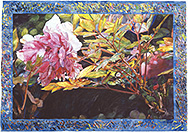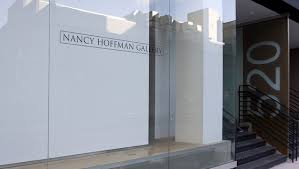
by Paul Zelanski and Mary Pat Fisher
6th edition
published by Prentice Hall
Although unity is a traditional objective in art, many contemporary artists have departed from tradition to create works that do not look or feel unified.
In Joseph Raffael's SPRING,
everything seems to be out of balance;everything is competing for our attention.
The bright yellow leaves are even more saturated than the peony blossom, which also tries to catch the eye but is interrupted by some leaf fragments springing up from the left.
Even the surrounding mat competes with the rest of the watercolor, for it is neither colored nor neutral; rather, it also presents fragments of intense hues for our consideration.
Using this explosion of colors, the artist suggests the eruption of vibrant life from the darkness of winter in northern climates, and also the spiritual energy permeating visible life forms.
Joseph Raffael has shared with us his feelings about use of color:
"The older I get, the more I feel that color is what painting is.
Painting is primarily color.
Theoretically I learned that at the beginning, perhaps it was Albers from whom I first heard it,
but here I am now, in these twilight skies, knowing that, for me, painting is color.
And because my works are primarily about the act of painting while using nature's realm as point of departure, (or is it point of arrival?)-----
and that I feel nature in all its mystery and spiritual breath can best be expressed by color's energetic spectrum.
Color is a language. It is the language of painting. How painting expresses itself is in large part wth color.
With all its variety and liveliness, color acts in the work of art as blood does as it circulates through our bodies. Color is what keeps the painting alive and moving.
When I paint, it is basically the putting of one color next to another ----- that's really what I do.
Colors building slowly and inevitably, constructting and creating what is to be born in the painting-to-be.
One color appears, and then another one goes next to it, then another lies itself over a color, and then a spot here, a speck there,
and then an air of a color there, then a glob of color there.
A kind of democratic state is born as all these individual color beings join together, living,working and playing together in one space.
I believe that the more color surprises reveal themselves, the more the painting will be rich, more like life, in all its revelations of the unexpected,
the never known before, the inevitable being made manifest
Let the tapestry be as full as possible.
Let the colors sing and zing.
Let colors speak their language of life.
Painting is primarily color".
This iconoclastic, intuitive approach is a counterpoint to heavily theoretical, intellectual approaches to color theory............

SPRING, 2003
Watercolor on paper, 45 x 63 inches
Nancy Hoffman Gallery,
New York





